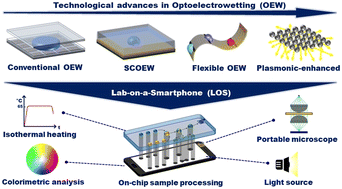A review of optoelectrowetting (OEW): from fundamentals to lab-on-a-smartphone (LOS) applications to environmental sensors
Abstract
Electrowetting-on-dielectric (EWOD) has been extensively explored as an active-type technology for small-scale liquid handling due to its several unique advantages, including no requirement of mechanical components, low power consumption, and rapid response time. However, conventional EWOD devices are often accompanied with complex fabrication processes for patterning and wiring of 2D arrayed electrodes. Furthermore, their sandwich device configuration makes integration with other microfluidic components difficult. More recently, optoelectrowetting (OEW), a light-driven mechanism for effective droplet manipulation, has been proposed as an alternative approach to overcome these issues. By utilizing optical addressing on a photoconductive surface, OEW can dynamically control an electrowetting phenomenon without the need for complex control circuitry on a chip, while providing higher functionality and flexibility. Using commercially available spatial light modulators such as LCD displays and smartphones, millions of optical pixels are readily generated to modulate virtual electrodes for large-scale droplet manipulations in parallel on low-cost OEW devices. The benefits of the OEW mechanism have seen it being variously explored in its potential biological and biochemical applications. This review article presents the fundamentals of OEW, discusses its research progress and limitations, highlights various technological advances and innovations, and finally introduces the emergence of the OEW technology as portable smartphone-integrated environmental sensors.

- This article is part of the themed collection: Lab on a Chip HOT Articles 2022


 Please wait while we load your content...
Please wait while we load your content...
